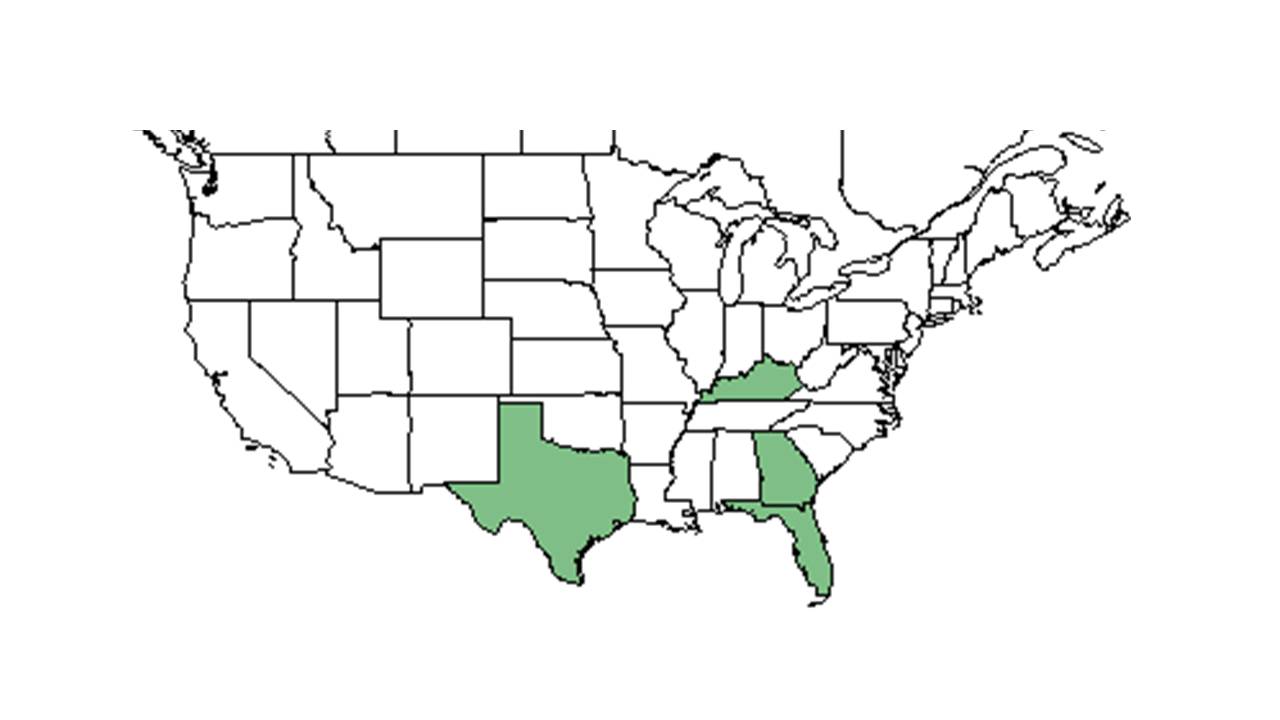Mimosa quadrivalvis
| Mimosa quadrivalvis | |
|---|---|

| |
| Photo take by Michelle M. Smith | |
| Scientific classification | |
| Kingdom: | Plantae |
| Division: | Magnoliophyta - Flowering plants |
| Class: | Magnoliopsida – Dicotyledons |
| Order: | Fabales |
| Family: | Fabaceae ⁄ Leguminosae |
| Genus: | Mimosa |
| Species: | M. quadrivalvis |
| Binomial name | |
| Mimosa quadrivalvis L. | |

| |
| Natural range of Mimosa quadrivalvis from USDA NRCS Plants Database. | |
Contents
Description
Common name: fourvalve mimosa
This species is frequent where it is found and has a sprawling behavior (FSU Herbarium). It is a vining plant that creeps and crawls as well (FSU Herbarium).
Distribution
Ecology
In a study comparing N2 fixation potential in nine legume species occurring in longleaf pine-wiregrass ecosystems, M. quadrivalvis showed clear superiority in developing a comparatively large nodule mass to support high N2 fixation activity (Cathey et al. 2010). Aboveground N concentration was also greatest for M. quadrivalis (Cathey et al. 2010). Finally, N2 fixation potential for M. quadrivalvis does not differ between shaded and unshaded environments (Cathey et al. 2010). The high potential for N2 fixation makes M. quadrivalvis a candidate species for contributing to the N economy in the restoration of longleaf pine ecosystems (Cathey et al. 2010).
Habitat
This species has been found in open pinewoods, oak-scrub woodlands, prairies, limestone glades, deciduous forests, turkey oak-pinelands, savannas, well drained ridges, ungrazed native grasslands, arroyos, and bare chalk areas (FSU Herbarium). It is commonly found in pine sandhill environments (Downer 2012). Occurs in areas that have sandy loam, peat, gravel, and/or clay loam that is dry, loose, or moist (Miller et al 1999, FSU Herbarium). Mimosa quadrivalvis is predominately in native groundcover with a statistical affinity in upland pinelands of South Georgia (Ostertag and Robertson 2007). This species can be found growing in open to semi-shaded areas (FSU Herbarium).
Phenology
This species has been observed flowering in February as well as April through September and fruiting from April through September (FSU Herbarium).
Seed dispersal
Dispersal is by gravity (Maza-Villalobos et al 2011).
Seed bank and germination
Fire ecology
This species has been found in areas that are burned (FSU Herbarium).
Pollination
Mark Deyrup at Archbold Biological Station observed these Hymenoptera species on Mimosa quadrivalvis
Colletidae Colletes distinctus
Halictidae Agapostemon splendens
Halictidae Augochlorella aurata
Halictidae Augochloropsis metallica
Halictidae Augochloropsis sumptuosa
Halictidae Lasioglossum miniatulus
Halictidae Lasioglossum nymphalis
Halictidae Lasioglossum placidensis
Sphecidae Prionyx thomae
Use by animals
Deyrup observed these bees, Agapostemon splendens, Augochlorella aurata, Augochloropsis sumptuosa, Dialictus miniatulus, D. placidensis, Anthidiellum perplexum on M. quadrivalvis (Deyrup et al 2002).
Diseases and parasites
Conservation and Management
Cultivation and restoration
Photo Gallery
References and notes
Cathey, S. E., L. R. Boring, et al. (2010). "Assessment of N2 fixation capability of native legumes from the longleaf pine-wiregrass ecosystem." Environmental and Experimental Botany 67: 444-450.
Deyrup, M. J. E., and Beth Norden (2002). "The diversity and floral hosts of bees at the Archbold Biological Station, Florida (Hymenoptera: Apoidea)." Insecta mundi 16(1-3).
Downer, M. R. (2012). Plant species richness and species area relationships in a Florida sandhill community. Integrative Biology. Ann Arbor, MI, University of South Florida. M.S.: 52.
Florida State University Robert K. Godfrey Herbarium database. URL: http://herbarium.bio.fsu.edu. Last accessed: June 2014.
Collectors: Edwin L. Tyson, J. Dwyer, Kurt Blum, Robert L. Lazor, Loran C. Anderson, J, Craddock Burks, Grady W. Reinert, R.C. Phillips, Gary R. Knight, Norlan C. Henderson, R. Kral, A.F. Clewell, Robert K. Godfrey, William Reese, Paul Redfearn, J.P. Gillespie, Nancy Caswell, Richard S. Mitchell, Patricia Elliot, Gwynn W. Ramsey, D. B. Ward, S. S. Ward, D.S. Correll, Robert J. Lemaire, L.S. Beard, R.O. Vail, W.B. Fox, Edward E. Terrell, S.B. Jones, Sidney McDaniel, V.L. Cory, Brunelle Moon, Cecil R. Slaughter, Robert R. Simons, Angus Gholson, Walter S. Judd, Bob Simons, Tom Morris, William Lindsey, Elmer C. Prichard, L.J. Brass, O. Lakela, John W. Thieret, Gerardo Garcia, Anastacio Bernal, Natalio Castillo, Guillermo Perez, Nick Lopez, W. L. McCart, D. S. Correll, I. M. Johnston, Duane Isely, F. L. Lewton, H. R. Reed, L. S. Beard, and R O Vail.
States and Counties: Florida: Calhoun, Citrus, Duval, Franklin, Gadsden, Highlands, Indian River, Jackson, Lake, Leon, Levy, Liberty, Madison, Marion, Nassau, Osceola, Pinellas, Polk, Suwannee, Taylor, Wakulla, Walton, and Volusia. Georgia: Seminole, and Thomas. Arkansas: Clark and Washington. North Carolina: Robeson and Rockingham. Alabama: Pickens and Sumter. Louisiana: Acadia. Texas: Andrews,Aransas, Callahan, Comal, Dallas, Denton, Dimmit, Ft. McKanepp, Haskell, Leon, Sutton, Taylor, Van Zandt, and Zapata. Kansas: Franklin. Missouri: Bates and Greene.
Countries: Panama.
Miller, J. H., R. S. Boyd, et al. (1999). "Floristic diversity, stand structure, and composition 11 years after herbicide site preparation." Canadian Journal of Forest Research 29: 1073-1083.
Maza-Villalobos, S., C. Lemus-Herrera, et al. (2011). "Successional trends in soil seed banks of abandoned pastures of a Neotropical dry region." Journal of Tropical Ecology 27: 35-49
Ostertag, T.E., and K.M. Robertson. 2007. A comparison of native versus old-field vegetation in upland pinelands managed with frequent fire, South Georgia, USA. Pages 109–120 in R.E. Masters and K.E.M. Galley (eds.). Proceedings of the 23rd Tall Timbers Fire Ecology Conference: Fire in Grassland and Shrubland Ecosystems.